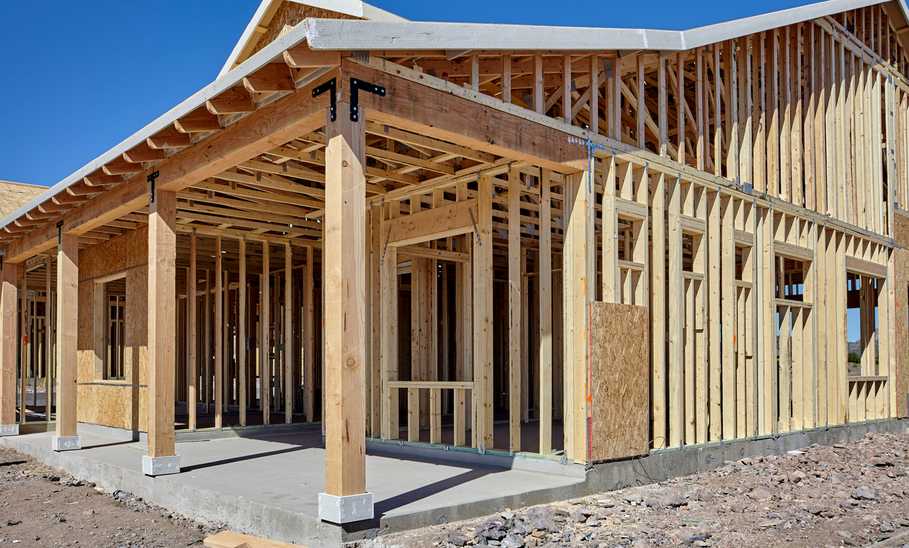What are Construction to Permanent Loans?


Our evaluations and opinions are not influenced by our advertising relationships, but we may earn a commission from our partners’ links. This content is created by TIME Stamped, under TIME’s direction and produced in accordance with TIME’s editorial guidelines and overseen by TIME’s editorial staff. Learn more about it.
If you’re looking to build a new home from scratch, you might want to use a construction-to-permanent loan. These loans will cover everything needed to build your dream house but then convert into a conventional mortgage once construction is complete.
Within this article, we’re going to discuss how construction-to-permanent loans work and why they’re a great option for construction financing.
Construction-to-permanent loans are one of the financing options available if you’re building a new home. These loans operate in two different phases.
While the house is being built you’ll be in the construction phase of the loan, and you’ll only need to make interest payments. The amount you borrow during this phase covers the costs associated with the land, materials, and labor needed to build the home. The construction loan phase typically lasts somewhere between six months and two years.
After the construction process has ended, the loan is then converted into a permanent mortgage. During the permanent phase of the loan, you’ll make ordinary mortgage payments that include the principal and interest.
Getting a construction-to-permanent loan is very similar to getting a traditional mortgage. You’ll go through an application process. In order to be approved, you’ll need to give the lender proof of your income, debts, credit history, and any other relevant financial information. The lender will also order an appraisal. You’ll also need to provide the bank with the blueprints, design, and price of the home, as well as the contract you’ve signed with the builder.
Getting approved for this type of loan can take longer than getting approved for a traditional mortgage, because the bank will also need to review construction plans and contracts.
Once you’re approved, you’ll be able to access funds and start paying contractors for different phases of the build.
As you start to consider the financing options available for your home, it’s crucial that you weigh all the facts. Here are a few of the pros for using a construction-to-permanent loan.
One of the perks of using a construction-to-permanent loan is that you only have to pay closing costs once. If you took out a construction loan and then a conventional mortgage once the home was completed, you’d be paying closing costs on both loans, which could cost you thousands of dollars.
With construction-to-permanent loans you’ll only draw on the money you need to pay contractors. This means you’ll only pay interest on the funds you actually use to build the home.
While the home is in the construction phase, borrowers using a construction-to-permanent loan will only need to make interest payments. This helps reduce the cost for the borrower while the home is being built, which means that they won’t be spending as much money until they can actually live in the home.
While construction-to-permanent loans have some benefits, they aren’t the right fit for everyone.
Typically a mortgage is backed by the property itself. If the borrower fails to make payments on the loan, the lender can take possession through foreclosure. However, since the home is in the construction phase, the lender is taking on additional risk. Because of the increased risk, borrowers typically have to pay higher interest rates on construction-to-permanent loans than on a traditional mortgage.
Because a construction loan is riskier than a mortgage loan, lenders typically require a down payment of at least 20%. If you’re buying a home that already exists, you may be able to spend as little as 3.5% on a down payment from US Bank.
There’s a lot that you’ll need to do before construction can begin on your new home.
Before you even apply for a loan you’ll need to select a builder for your project. If you need leads for potential builders, ask friends and family if they know of anyone reputable. You can also use sites like Angi.com as a resource.
Once you find a few possibilities, look at reviews from previous clients. These will typically give you a good idea of how the process went for others. You can also ask for references and any images from homes they’ve recently built.
You’ll need to get your home design, construction plans, and budget finalized before you can apply for the loan.
The next thing you’ll need to do is choose a lender. This process will be very similar to finding a traditional mortgage. You’ll want to speak with several lenders to see which will offer you the most favorable terms.
Once you decide which lender you want to use, it’s time to start the approval process. In order to be approved, you’ll need to provide the lender with proof of income, tax returns, bank statements, and other financial documents. You’ll also need to provide the lender with building plans which go through the estimated costs for each part of the project.
When you purchase a home with a mortgage, lenders will require you to take out a homeowners insurance policy to protect their investment. However, when you build a home from scratch, the process is slightly different. Lenders will most likely require you to take out builder’s risk insurance during the construction phase. This helps protect you financially, which means it also protects the lender’s investment throughout the building process.
Before you’ll be approved for a construction-to-permanent loan, your lender is going to require a few things from you. These include:
You don’t always have to do a single-closing transaction to get construction-to-permanent financing. Depending on your lender, this can be accomplished in a few different ways.
Some lenders are going to offer a single closing transaction. This helps to streamline the process and reduces the cost. Instead of going through the application and closing process for both a construction and permanent loan, you will do everything at once.
If you’re building a home during a time when interest rates have been falling, it might make sense to use a two-closing transaction. With this, you would go through the application and closing process for the construction loan and then pay that loan off using a traditional mortgage once construction is complete.
Interest rates for traditional mortgages are typically lower than interest rates for construction-to-permanent loans, which can help you make up for the amount you’ll pay in additional closing costs. That being said, you’ll also need to consider the risk that you might not qualify for a traditional mortgage after construction is completed.
If you’ve decided against using a single closing transaction loan, you could choose to use a limited cash-out refinance. Because you’ll be required to pay closing costs a second time on the permanent loan, a limited cash-out refinance will allow you to package the second set of closing costs into your permanent loan instead of paying for them out of pocket.
If you’re interested in looking at other loan options, here are a few alternatives to the typical construction loans that you might want to consider.
If you’re looking to build a home in a rural area with a population of 35,000 or less, and your income doesn’t exceed the USDA limits, you might qualify for a USDA combination construction-to-permanent loan. No down payment is required and the minimum credit score is just 640. USDA construction loans use a single close transaction, helping you save money on closing costs.
If you’re either active or retired military you might qualify for a construction loan through the U.S. Department of Veteran Affairs (VA). Like the USDA construction loan, you won’t need a down payment to qualify for a VA construction loan. The minimum credit score for this type of loan is 620.
If you can only afford a small down payment saved up and your credit is less than stellar, you might be able to qualify for an FHA one-time close construction loan. These are backed by the Federal Housing Authority (FHA) and are available to borrowers with a credit score of at least 580, although some lenders will require credit scores in the mid 600s, and a down payment of at least 3.5%.
Like other one-time close construction loans, an FHA one-time close construction loan allows you to finance the land, builder fees, materials, and closing costs. Once the build is completed it will automatically roll into a permanent loan.
Construction-to-permanent loans and construction loans are similar because they both provide financing to build a new home. However, the major difference is that a construction-to-permanent loan combines both the construction loan and permanent loan in a single transaction. If you wanted to roll the costs of an ordinary construction loan into a mortgage, you would need to apply for a separate permanent loan and pay the associated closing costs.
Construction-to-permanent loans and HELOCs have some similarities. With both, you have the ability to draw on the loan amount and only pay interest during the draw period. However, a HELOC is based on the equity in an existing home. This makes it a great option for home renovations, but can’t be used if there isn’t already an existing home to borrow against.
When you use a construction loan, you never actually see the funds. Once work has been completed, the lender pays the builder directly to cover the costs. If the total costs of construction ends up being below what was budgeted, you won’t have access to the funds left over. Any home furnishings will need to be paid for out of pocket, or by taking out a personal loan or line of credit.
No. If you’re building a home, you will need to pay for the design aspect of the build out of pocket.
Yes, when you close on your construction-to-permanent loan, you will lock in your interest rate. Even if mortgage rates rise during the building process, you will still enjoy the low rate you locked in when you signed the contract.
Lenders will typically set up an interest reserve account on construction loans. The purpose of this is to pay for the interest on the amount drawn. The exact amount will depend on different variables such as the loan amount, the average percentage of loan amount that’s outstanding, the interest rate, and how long construction is expected to take.
The information presented here is created by TIME Stamped and overseen by TIME editorial staff. To learn more, see our About Us page.



